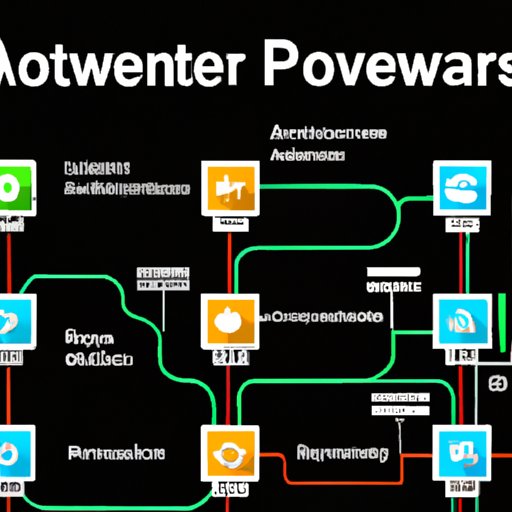Introduction
Power Automate Flow is a powerful tool from Microsoft that enables users to automate tedious tasks, streamline complex processes, and enhance data management. It’s an essential part of the Microsoft Power Platform and has been widely adopted by businesses of all sizes. In this article, we’ll explore what Power Automate Flow is, its benefits, and how to use it for automation.
What is Power Automate Flow?
Power Automate Flow is part of the Microsoft Power Platform and is designed to help users automate business processes and workflows. With Power Automate Flow, users can create automated workflows, or “flows,” that are triggered by specific events or user actions. These flows can be used to automate repetitive tasks and streamline complex processes, saving time and increasing efficiency.

Benefits of Using Power Automate Flow
Using Power Automate Flow offers many benefits, including:
- Automating tedious tasks such as data entry
- Streamlining complex processes
- Enhancing data management
- Reducing costs associated with manual labor
- Increasing efficiency and productivity
- Enabling collaboration between teams
How to Use Power Automate Flow for Automation
Using Power Automate Flow for automation requires a step-by-step approach. Here’s a brief overview of the process:
Step-by-Step Guide
- Plan your flow: Identify the tasks you want to automate and map out the steps needed to complete them.
- Set up triggers: Determine when and how the flow should be triggered.
- Add actions: Select and configure the actions you want the flow to perform.
- Connect data sources: Connect to any data sources you need to access (e.g., databases, files, etc.).
- Add conditions: Add any conditions needed to control when an action should be performed.
- Test and optimize: Test the flow and make any necessary adjustments.
- Publish: Publish the flow and start automating your processes.
Important Considerations
When using Power Automate Flow for automation, it’s important to keep the following considerations in mind:
- Understand the business process: Make sure you understand the process you’re trying to automate before building the flow.
- Plan the flow: Map out the flow before building it to ensure it will meet your needs.
- Test and optimize: Regularly test and optimize your flows to ensure they are working as expected.
- Security: Make sure you have the necessary security measures in place to protect your data.

An Overview of Power Automate Flow Features
Power Automate Flow provides several features to help users automate their processes. Let’s take a look at some of the key ones.
Triggers
Triggers are the events that initiate a flow. They can be user actions (such as clicking a button) or system events (such as new emails arriving in a mailbox).
Actions
Actions are the tasks that the flow will perform. They can range from simple tasks (such as sending an email) to more complex ones (such as calling an API).
Connectors
Connectors are used to connect to external data sources. They enable the flow to access data from databases, files, and other systems.
Conditions
Conditions are used to control when an action should be performed. For example, you can use conditions to ensure that an action is only performed if certain criteria are met.
Best Practices for Building a Power Automate Flow
When building a Power Automate Flow, there are several best practices that you should follow to ensure the flow is effective and efficient. Here are some of the most important ones.
Understanding the Business Process
Before building a flow, it’s important to take the time to understand the business process you’re trying to automate. This will ensure that the flow meets the needs of the organization.
Planning the Flow
Once you understand the process, it’s time to plan the flow. Map out the steps needed to complete the task and determine which triggers and actions are needed to accomplish it.
Testing and Optimizing
Regularly test and optimize the flow to ensure it is working as expected. This will help you identify any potential issues and make any necessary adjustments.

Power Automate Flow: Making Workflows Easier and More Efficient
Power Automate Flow is a powerful tool that can help businesses automate tedious tasks, streamline complex processes, and enhance data management. Here are some of the ways it can do this.
Automating Tedious Tasks
Power Automate Flow can be used to automate mundane, repetitive tasks such as data entry. This can save time and reduce costs associated with manual labor.
Streamlining Complex Processes
Power Automate Flow can also be used to streamline complex processes. By automating steps within a process, users can reduce errors and increase efficiency.
Enhancing Data Management
Finally, Power Automate Flow can be used to enhance data management. By connecting to external data sources, users can easily access and manage data from multiple systems.
Conclusion
Power Automate Flow is a powerful tool from Microsoft that enables users to automate tedious tasks, streamline complex processes, and enhance data management. By understanding the business process, planning the flow, and testing and optimizing regularly, users can ensure that their flows are effective and efficient. Power Automate Flow can help businesses save time, reduce costs, and increase efficiency, making it an invaluable part of any organization’s workflow.
(Note: Is this article not meeting your expectations? Do you have knowledge or insights to share? Unlock new opportunities and expand your reach by joining our authors team. Click Registration to join us and share your expertise with our readers.)
